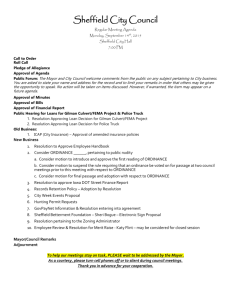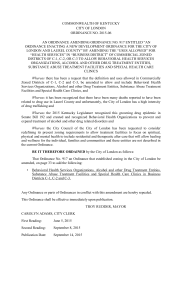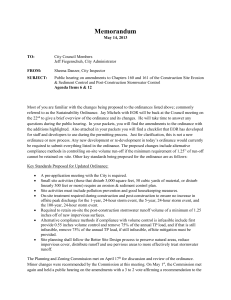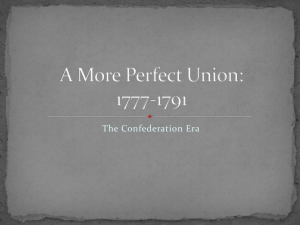373-2014 Ordinance
advertisement
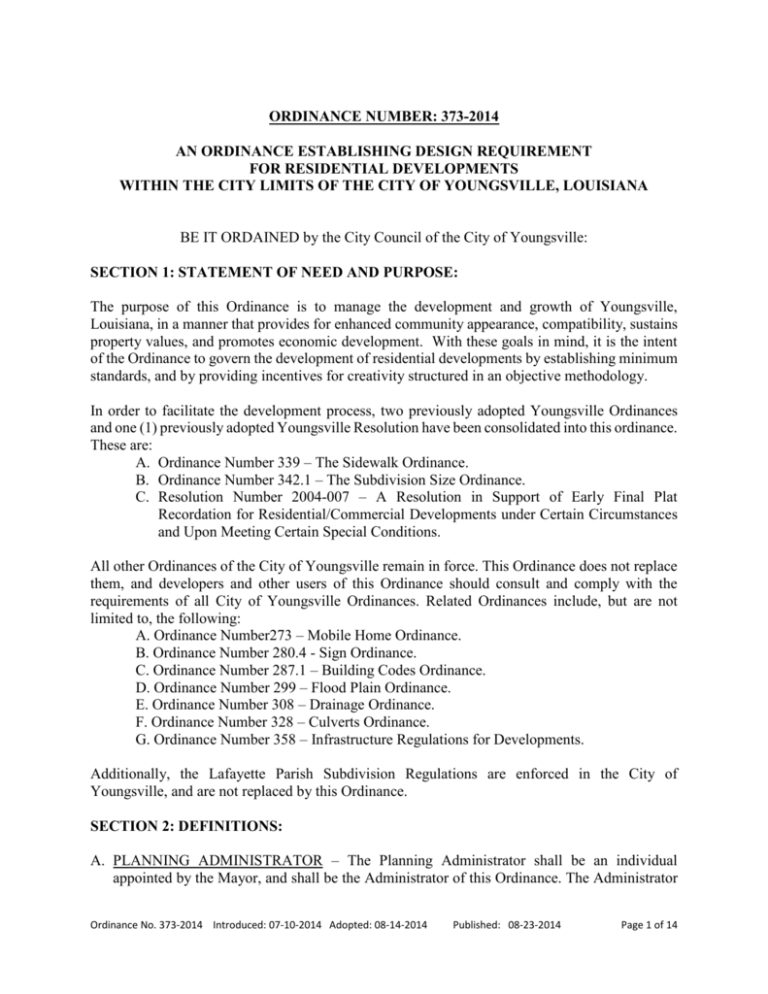
ORDINANCE NUMBER: 373-2014 AN ORDINANCE ESTABLISHING DESIGN REQUIREMENT FOR RESIDENTIAL DEVELOPMENTS WITHIN THE CITY LIMITS OF THE CITY OF YOUNGSVILLE, LOUISIANA BE IT ORDAINED by the City Council of the City of Youngsville: SECTION 1: STATEMENT OF NEED AND PURPOSE: The purpose of this Ordinance is to manage the development and growth of Youngsville, Louisiana, in a manner that provides for enhanced community appearance, compatibility, sustains property values, and promotes economic development. With these goals in mind, it is the intent of the Ordinance to govern the development of residential developments by establishing minimum standards, and by providing incentives for creativity structured in an objective methodology. In order to facilitate the development process, two previously adopted Youngsville Ordinances and one (1) previously adopted Youngsville Resolution have been consolidated into this ordinance. These are: A. Ordinance Number 339 – The Sidewalk Ordinance. B. Ordinance Number 342.1 – The Subdivision Size Ordinance. C. Resolution Number 2004-007 – A Resolution in Support of Early Final Plat Recordation for Residential/Commercial Developments under Certain Circumstances and Upon Meeting Certain Special Conditions. All other Ordinances of the City of Youngsville remain in force. This Ordinance does not replace them, and developers and other users of this Ordinance should consult and comply with the requirements of all City of Youngsville Ordinances. Related Ordinances include, but are not limited to, the following: A. Ordinance Number273 – Mobile Home Ordinance. B. Ordinance Number 280.4 - Sign Ordinance. C. Ordinance Number 287.1 – Building Codes Ordinance. D. Ordinance Number 299 – Flood Plain Ordinance. E. Ordinance Number 308 – Drainage Ordinance. F. Ordinance Number 328 – Culverts Ordinance. G. Ordinance Number 358 – Infrastructure Regulations for Developments. Additionally, the Lafayette Parish Subdivision Regulations are enforced in the City of Youngsville, and are not replaced by this Ordinance. SECTION 2: DEFINITIONS: A. PLANNING ADMINISTRATOR – The Planning Administrator shall be an individual appointed by the Mayor, and shall be the Administrator of this Ordinance. The Administrator Ordinance No. 373-2014 Introduced: 07-10-2014 Adopted: 08-14-2014 Published: 08-23-2014 Page 1 of 14 B. C. D. E. F. G. has no authority to waive any portion of this Ordinance. Final authority on all matters rest with the City Council. TRAFFIC CALMING DEVICES – A projection or deviation in a road that has the purpose of slowing traffic, such as a small round-about or island; for the purpose of this ordinance, a “speed bump” and a “four-way stop” are not Traffic Calming Devices. COMMON OPEN SPACE - Those areas of a development that are owned and maintained by the Home Owners Association, and are for the use of all residents of the development. Common Open Space includes, but are not limited to, squares, plazas, greens, preserves, parks, ponds, golf courses, and greenbelts. URBAN EVENT – A part of the infrastructure that provides a variation to the surrounding context while also serving a purpose to the neighborhood. Examples of Urban Events include, but are not limited to, town squares, focal points, landscaped boulevards, and bends in a street. Examples of ways that an Urban Event can serve a purpose to the neighborhood include, but are not limited to, slowing traffic (thus becoming a Traffic Calming Device), or creating a gathering area for residents of the neighborhood. SIDEWALK – A path or pavement walkway located near the side of the street and installed specifically for use by pedestrians. SIDEWALK EASEMENT – A right granted by the property owner to the City of Youngsville establishing a real estate deed or on a recorded plat to permit the use of the land by the public for the specific use of placing a sidewalk. GREEN SPACE – That portion of a development which set aside and reserved as a plot of land separating or surrounding areas of intensive residential or industrial use and is maintained for recreational enjoyment, and includes retention/detention ponds. SECTION 3: LAND GOVERNED: A. All land within the city limits of Youngsville, Louisiana, that is not part of a development that was previously approved by earlier standards, is governed by this ordinance. a. Multi-phased developments that have some but not all phases built out are required to comply with this ordinance for the un-built phases, but can appeal to the Council for grand-fathering. b. Any property approved as a Traditional Neighborhood Development under the TND ordinance is not governed by this ordinance. SECTION 4: DESIGN STANDARDS AND INCENTIVES: A. Incentives: a. In addition to providing minimum Design Standards, this ordinance establishes an objective method for developers to be creative while assuring that each development having a “Positive” impact on the community. b. The methodology is to assign either a positive or negative number of points for each variation from the code; the total number of points earned by the development must be zero or greater. i. Positive Points are earned by enhancements that are greater than the minimum required, as listed below. Ordinance No. 373-2014 Introduced: 07-10-2014 Adopted: 08-14-2014 Published: 08-23-2014 Page 2 of 14 ii. Negative Points are earned by variances from the minimum required, as listed below. c. In order to be considered as “positive points”, the enhancements must be shown on the Preliminary Plat, and must be completed before the first lot is sold. i. A Letter of Credit will be required if the enhancements are not completed before the first residence is occupied. 1. The Letter of Credit will be for 1.25 times the value of the improvement, and will be callable by Youngsville after one year. 2. See “5.F” below for more requirements regarding Letters of Credit. d. Positive Points Menu: i. The following enhancements to Common Open Space will earn positive points: 1. Swimming Pools (minimum 1000sf): One (1) positive point per 1000 sf of water area. a. A minimum 10’ concrete (or approved hard-surface material) apron is required. 2. Tennis Courts: One (1) positive point per court. a. Only regulation courts will be considered. 3. Children’s Playground (minimum of 4 apparatus): One (1) positive point per four apparatus. 4. Dog Park (minimum of 0.5 acre): One (1) positive point per half-acre. 5. Community Garden/Organic Farm (minimum of 0.5 acre): One (1) positive point per half-acre. 6. Providing more Common Open Space than the 10% minimum: one (1) positive point for every 2% over the 10% minimum, with a maximum of five (5) positive points that can be earned this way. ii. Sidewalks/Bike Paths. 1. Adding benches and/or work-out stations along the path adds one (1) positive point if bench or station occurs every 250’, or less. iii. Buildings. 1. The following facilities earn positive points: a. Gazebo or Open-Air Pavilion (minimum 100sf): One-half (0.5) positive point per 100sf. b. Air Conditioned Clubhouse (minimum 2000sf): Four (4) positive points for first 2000sf, and one (1) credit for each additional 1000sf. c. Public Restroom Facilities (adjacent to a pool or other amenity; minimum of one unisex restroom): one (1) positive point. iv. Traffic Calming Devices. 1. Round-Abouts (minimum of 100sf, with a curb that is at least 6” tall) earn one (1) positive point. 2. Landscaped Islands (minimum of 100sf, with a curb that is at least 6” tall) in street earn one (1) positive point. Ordinance No. 373-2014 Introduced: 07-10-2014 Adopted: 08-14-2014 Published: 08-23-2014 Page 3 of 14 3. Raised sections or raised sidewalks through a street earn one (1) positive point. 4. Textured crosswalks (e.g., Pavestone) earn one (1) positive point. v. Landscaping. 1. Along Streets. a. One Type “A” tree every 40’ of frontage earns two (2) positive points. Trees may be clustered, and need not be evenly spaced. b. One Type “B” tree every 20’ of frontage earns two (2) positive points. Trees may be clustered, and need not be evenly spaced. 2. Perimeter of development. a. Perimeter landscaping is in addition to the required fence. b. One Type “A” tree every fifty (50) feet or one Type “B” tree every twenty-five (25) feet earn two (2) incentive points. c. Continuous shrubs earn one (1) incentive point. 3. Landscaping must be maintained by the Home Owners Association. 4. Type “A” trees are trees that normally grow to an overall height of approximately 50’, shall be a minimum 2” caliper and minimum height of 10’ when planted, and include but are not limited to the following: Southern Magnolia, Pine, Live Oak, Willow Oak, Bald Cypress, and Elm. Other species may be considered. 5. Type “B” trees are trees that normally grow to an overall height of approximately 25’, shall be a minimum of 1.5” caliper and minimum height of 8’ when planted, and include but are not limited to the following: River Birch, Cedar, Redbud, Dogwood, Mayhaw, Silver Bell, Crape Myrtle, Sweetbay Magnolia, Wax Myrtle, and Sweet Olive. Other species may be considered. 6. Shrubs are defined as low, usually multi-stemmed, self-supporting, woody plant species. Approved shrubs include azaleas, gardenia, sago palms, holly, palmetto, ligustrum, bottlebrush, ginger, and bananas. Other species may be considered. B. Design Standards. a. Lot Sizes: i. For preliminary plat approval of single family residential developments, the average size of all residential lots shall be a minimum of six thousand (6,000) square feet for front loaded lots, and five thousand (5,000) square feet for back loaded lots. 1. For front loaded lots, the minimum without incentives is six thousand (6,000) square feet, but if incentives are provided, the absolute minimum is five thousand four hundred (5,400 square feet, and the following negative points apply: a. 5900-5999sf lots earn one (1) negative point. b. 5800-5899sf lots earn two (2) negative points. c. 5700-5799sf lots earn three (3) negative points. d. 5600-5699sf lots earn four (4) negative points. Ordinance No. 373-2014 Introduced: 07-10-2014 Adopted: 08-14-2014 Published: 08-23-2014 Page 4 of 14 e. 5500-5599sf lots earn five (5) negative points. f. 5400-5499sf lots earn six (6) negative points. 2. For back loaded lots, the minimum without incentives is five thousand (5,000) square feet, but if incentives are provided, the absolute minimum is four thousand five hundred (4,500 square feet, and the following negative points apply: a. 4900-4999sf lots earn one (1) negative point. b. 4800-4899sf lots earn two (2) negative points. c. 4700-4799sf lots earn three (3) negative points. d. 4600-4699sf lots earn four (4) negative points. e. 4500-4599sf lots earn five (5) negative points. 3. Any portion of a development that is identified and/or set aside with the intention of being used for industrial or commercial endeavors shall be so marked on the preliminary and final plat, and shall not be included in the calculations of the average residential lot size. 4. All variances from the average minimum lots size requirements and lot frontage requirements will be considered on a case by case basis by the city council. b. Lot Widths: i. For preliminary plat approval of single family residential developments, the minimum size of the lot property line adjacent to the street shall be fifty-five (55) feet for front loaded lots and forty-five (45) feet for back loaded lots. 1. For front-loaded lots, the minimum lot width without incentives is fiftyfive (55) feet, but if incentives are provided, the absolute minimum is fifty (50) feet, and the following negative points apply: a. 52.5’-54.9’ lots earns two (2) negative points. b. 50.0’-52.4’ lots earns four (4) negative points. 2. For back-loaded lots, the minimum lot width without incentives is fortyfive (45) feet, but if incentives are provided, the absolute minimum is forty (40) feet, and the following negative points apply: a. 42.5’-44.9’ lots earns two (2) negative points. b. 40.0’-42.4’ lots earns four (4) negative points. 3. For preliminary plat approval of single family residential developments, the minimum size of the lot property line adjacent to the street for wedge-shaped lots or lots fronting on a cul-de-sac will be twenty five (25) feet, with consideration being given for an exemption of the average lot size on a case by case basis, subject to approval of the City Council. c. Setbacks: i. Refer to the Lafayette Parish Subdivision Regulations. d. Common Open Space: i. A minimum of ten percent (10%) Common Open Space is required for all residential developments where lots are available for sale or re-sale to the Ordinance No. 373-2014 Introduced: 07-10-2014 Adopted: 08-14-2014 Published: 08-23-2014 Page 5 of 14 general public, if no incentives are provided. If incentives are provided, then an absolute minimum of five percent (5%) is required, and the following negative points apply: 1. 9 – 9.9% Common Open Space earns one (1) negative point. 2. 8 – 8.9% Common Open Space earns two (2) negative points. 3. 7 – 7.9% Common Open Space earns three (3) negative points. 4. 6 – 6.9% Common Open Space earns four (4) negative points. 5. 5 – 5.9% Common Open Space earns five (5) negative points. e. Amenities: i. All amenities are to be maintained by Home Owners Association. ii. A sign and landscaping are required at the main entrance of the development. 1. One (1) permanent subdivision sign is required at each entrance to a subdivision, with the following requirements: a. Such sign shall contain only the name of the subdivision and motto, if any. It shall not contain promotional material. b. The sign shall not create a physical or visual hazard for motorists entering or leaving the subdivision. c. An acceptable legal entity shall be provided to assure the maintenance of the subdivision sign. d. The sign shall not exceed seven (7) feet in height. e. The sign shall not exceed fifty (50) square feet in area. 2. Providing the following Landscaping earns one (1) positive point: a. A fence that is a minimum of 20’ wider than the sign, on both sides of the entrance drive. i. Fence is to be built of brick or other permanent, preapproved material. ii. Fence is to be a minimum of 5’ and maximum of 8’ tall, except end-posts (if any) may extend another 12”. iii. The fence shall not create a physical or visual hazard for motorists entering or leaving the subdivision. b. Provide a landscaped area at least 5’ wide between the sign and the fence, and 5’ beyond the sign on the sign side of the entrance drive, and an equal area on the non-sign side of the entrance drive. i. A minimum of two native shade trees with a minimum caliper of two and one-half inches (2.5”) at the time of planting is required on each side of the entrance drive. ii. Native grasses, shrubs, vines, or other flowering plants are required to fill the landscape area. iii. Recreation amenities (swimming pools, tennis courts, children playgrounds, etc.) count as part of the required Common Open Space. Ordinance No. 373-2014 Introduced: 07-10-2014 Adopted: 08-14-2014 Published: 08-23-2014 Page 6 of 14 f. Streets: i. At least one guest parking space is required at the street when lots are back loaded. ii. Street parking shall not reduce the width of the two lanes of travel. iii. Streets that exceed 1500 feet in length must be interrupted by a Traffic Calming Device or an Urban Event. iv. Developments of fifty (50) or more lots that have its main entry from a Major Thoroughfare Road (as defined by the Lafayette Consolidated Government’s Thoroughfare Map), shall provide turning lanes on the Major Thoroughfare. In lieu of providing the turning lanes, the developer can pay an impact fee to the City of Youngsville, which in turn will be used to build the turning lanes. g. Alleys: i. All alleys are to be constructed of concrete. ii. Sub-surface drainage is required in all alleys. iii. Alleys will have a minimum 27’ right-of-passage (not right-of-way), with minimum 10’ paving width. 1. Parking is not allowed on the 10’ paving width. h. Parking: i. Front loaded lots. 1. A minimum of two (2) parking spaces are required, on the lot for the exclusive use of the lot owner. a. These spaces may be in a garage or carport. If the two spaces are located in a garage or carport, then one (1) additional parking space per lot is required. b. The additional parking space can be on the lot, or it can be on the street. ii. Back loaded lots. 1. A minimum of two (2) parking spaces are required, one of which must be on the street and must be designated for guests. i. Retention Ponds: i. The following is required: 1. Retention Ponds shall not exceed the design depth as determined by the Lafayette Parish Subdivision Regulations by more than 50%. a. Any pond exceeding the design depth by more than 50% shall be considered a borrow pit, and will be governed by the Youngsville Performance Land Use Ordinance. 2. The digging of the Retention Pond must occur in concert with the installation of other infrastructure of the development. 3. The Retention Pond must be maintained continuously, either by the developer or by the Home Owners Association. 4. To count as Common Open Space, ponds are to be visible and accessible by the public along public roads. 5. Ponds are to be aerated to count as Common Open Space. Ordinance No. 373-2014 Introduced: 07-10-2014 Adopted: 08-14-2014 Published: 08-23-2014 Page 7 of 14 6. Children’s playgrounds are not allowed next to ponds. 7. Detention ponds can only account for 50% of Common Open Space. 8. Feature (non-detention) ponds (e.g., the pond in Sugar Mill Pond) can account for 100% of Common Open Space. j. Sidewalks. i. Sidewalks are required on both sides of all streets. If a development borders an existing or proposed street on one side only, it will be required to provide sidewalks on that side of the street only. If a development borders an existing or proposed street on both sides, it will be required to provide sidewalks on both sides of the street. If a lot within the development has access to a street in front and back of the lot, it will be required to provide sidewalks on both streets. If a development borders an intersection of two streets, it will be required to provide sidewalks on both streets. ii. Sidewalk requirements are not retroactive, and are not required in subdivisions that received approval prior to the effective date of this ordinance. iii. Sidewalks are not required in Alleys where the purpose of the alley is to serve as driveways for the lots. iv. The sidewalk is required to be a minimum of four feet (4’) wide, meet ADA requirements, and the following minimum standards: 1. Constructed of a minimum of 2500 psi Portland Cement concrete and a minimum of four inch (4”) thick, and 2. Have a minimum of three-quarter inch (3/4”) thick redwood expansion joints installed at a maximum of every twenty-eight feet (28’), and 3. Have scored contraction joints at a maximum of seven feet (7’), and 4. Sidewalks across driveways or that will be crossed by vehicles are to be a minimum of six inches (6”) thick, and 5. The soil beneath the sidewalk will either be natural undisturbed soil, or if it has been disturbed or filled, will be compacted to ninety percent (90%) standard proctor, and 6. The sidewalk will be given a smooth finish then lightly scored by brush or broom to produce a surface texture that minimizes pedestrian slippage in wet weather, and 7. The sidewalks will be continuous throughout the development, and 8. The sidewalk may be sloped for terrain and drainage, but not to exceed a slope of one on twenty (1/20), and 9. The sidewalk must be without an obstacle or bump that will impede, trip or present a safety hazard for pedestrians, and 10. At street corners the sidewalk in both directions will extend to the pavement edge. If a ditch culvert is required to accomplish this, it will be considered part of the sidewalk requirement. The size and grade of the culvert will be determined by the development engineer, subject to the approval of the City of Youngsville’s Engineer, and 11. Handicapped ramps will be constructed by the developer as required by law to meet ADA requirements, and Ordinance No. 373-2014 Introduced: 07-10-2014 Adopted: 08-14-2014 Published: 08-23-2014 Page 8 of 14 v. vi. vii. viii. 12. Sidewalks shall not be less than two feet (2’) from the back of curb or edge of pavement. The developer must construct sidewalks either in public street right-of-ways or in a sidewalk easement on the development property. 1. Where possible, the sidewalk is to be built in the public right-of-way, such that the development side edge of the sidewalk is on the right-ofway line and the four foot sidewalk width is in public right-of-way. 2. If the situation of the street right-of way width, utilities, topography, existing ditches, etc., prevent the construction of the sidewalks in the public right-of-way, the sidewalk will be constructed in a minimum four foot (4’) wide Sidewalk Easement that is so designated on the preliminary and final plat. The Sidewalk Easement may be located within the utility easement. In the event the minimum three foot setback from the edge of any parking lot to the street right-of-way fall within the sidewalk easement, the setback will be measured from the edge of the sidewalk easement on the development side. 3. Whatever the case, public sidewalk locations must be considered at the time of preliminary design so that the provisions can be made for a smooth pedestrian traffic pattern that avoids obstacles (ditches, trees, utilities, etc.). This will also make the developer aware up front if a sidewalk easement will be necessary. Once sidewalks have been constructed and approved by the City of Youngsville in the designated sidewalk location or easement, the City of Youngsville will assume perpetual maintenance of these sidewalks provided they have been constructed to City of Youngsville sidewalk standards. When a letter of credit has been granted and is in effect and at least ninety percent (90%) of the subdivision lots have sidewalks constructed or under construction, construction of all remaining sidewalks will be installed by the contractor. Notification will be given to the developer by the City of Youngsville that all remaining sidewalks will be constructed prior expiration of the letter of credit. If the developer does not respond to this notification, the city of Youngsville will request the full amount of the letter of credit from the financial institution. The City of Youngsville will use the proceeds for the letter of credit to construct the remaining sidewalks. The developer will be responsible for any additional costs related to the construction of the sidewalks above the value of the letter of credit. A minimum 8’ sidewalk between the development and any public street that is adjacent to the development. k. Perimeter Fences. i. A perimeter fence is required where a development faces a public street, park, or other public property, must be: 1. Approved by the Planning Administrator or his designee prior to installation. 2. Continuous and constructed of uniform materials, construction, height, and color. Ordinance No. 373-2014 Introduced: 07-10-2014 Adopted: 08-14-2014 Published: 08-23-2014 Page 9 of 14 3. A neutral and uniform color, including support posts. 4. Include accent features every 100 feet (maximum). Accent feature can be brick or stucco columns, tree, or other distinguishing feature. 5. Able to withstand wind loads and other requirements established by the current International Building Code. 6. Shall not contain any poster, graphics, or advertising of any kind, unless mandated by Federal or State law. 7. Maintained by the Home Owners Association. l. Utilities. i. Only underground utilities are allowed. No overhead utilities will be approved or allowed. ii. The development shall tie into municipal utilities if they are available within 1500 feet of any part of the development. The cost of extending the utilities to the development is the responsibility of the developer. m. Home Owners Association (HOA): i. All residential developments are to be governed by a legally recorded HOA. ii. HOA documents, Covenants, and Restrictions are to clearly provide that each lot owner is party to and responsible for each, and must be recorded in the Lafayette Parish Clerk of Courts office before the first lot is sold. n. Multi-Phase Developments. i. Multi-phased developments that have some but not all phases built out are required to comply with this ordinance for the un-built phases, but can appeal to the Council for grand-fathering. ii. Whenever possible, the construction entry for later phases must not be thru earlier phases of the development, if the earlier phases are inhabited. If there are no other options and the construction entry for the second or subsequent phase(s) is thru the initial or prior phase(s), the developer of the subsequent phase(s) must warrant the work of the initial phase(s) for the same period as he is required to warrant the subsequent phase(s). This applies whether or not the developer of the subsequent phase(s) was the developer of the initial phase(s). SECTION 5: ADMINISTRATION BY THE PLANNING ADMINISTRATOR: A. Before a development can begin a construction or operation, the developer must furnish documentation to the Planning Administrator that is necessary to reasonably evaluate the development. a. If the developer is requesting a variance based on the incentives described herein, then the following is required: i. A letter on the developer’s stationary and signed by the developer, describing in detail the nature of his request. ii. A copy of the Home Owners Association documents. iii. A color drawing(s) (minimum size 24”x36”) showing in detail the master plan of the development. The drawing(s) should include the following: Ordinance No. 373-2014 Introduced: 07-10-2014 Adopted: 08-14-2014 Published: 08-23-2014 Page 10 of 14 1. A plan of the entire development showing every lot, street, adjacent streets, stop signs, street name signs, speed limit signs, and amenities. 2. A disclosure and description of all the “positive points” and “negative points”, including cut-sheets, details, etc. of all amenities, including ponds, signs, etc. Photographs of improvement amenities are encouraged, and need not be exact, but need to be representative of the actual item to be built or provided. The intent is to show the character of the development. 3. Two hard-copies of the drawing are required, as well as an electronic copy. iv. A spreadsheet listing all “positive points” and “negative points”, developed to show the net impact on the community. b. The burden is on the developer to provide adequate information for evaluation. B. Based on the information submitted, the Planning Administrator will prepare a letter to the developer documenting his evaluation of the development. C. If the developer wishes to appeal the decision of the Planning Administrator or request a waiver of any provision of this ordinance, the developer shall document the appeal or waiver request and submit the appeal or waiver request to the City Clerk a minimum of fifteen (15) days before the regular Council meeting. The City Clerk shall enter the appeal or waiver request on the next City Council meeting agenda. The decision of the Council shall be final. Only the Council can grant a variance. D. No building permit will be issued until plans for the development are in compliance. E. The approval of a development is good for one year. The developer can apply for one year extension due to extenuating circumstances. After these periods, the approval will be cancelled, and the developer will be required to re-apply. F. Letter of Credit. a. When and if a letter of credit is requested by the developer and approved by the City of Youngsville, the minimum amount will be the estimated construction cost as determined by the City of Youngsville Engineer, plus a 25% administration fee. The developer is solely responsible for the construction of the required improvements. The letter of credit expires after twelve (12) months. The amount of the letter of credit is to be adjusted as the development progresses and the improvements are constructed, inspected and approved by the City of Youngsville or when requested by the developer. b. A developer may request approval from the Mayor of the City of Youngsville for early recordation of a plat upon a showing that: a. The subdivision is eighty (80%) percent or more complete as determined in the sole discretion of the City Engineer with the concurrence of the Mayor, and that the estimated costs of completion of the residential development does not exceed $250,000.00; b. The developer and the engineer for the residential development, along with the City Engineer and the Mayor, have executed the Residential Improvements Agreement in conformity with the form approved by the administration of the City of Youngsville; c. In addition to the Residential Subdivision Improvements Agreement, the developer must also: Ordinance No. 373-2014 Introduced: 07-10-2014 Adopted: 08-14-2014 Published: 08-23-2014 Page 11 of 14 i. Provide an Irrevocable Letter Of Credit from a “Local Bank” defined as a banking institution doing business in the Parish of Lafayette, State of Louisiana, and operating branch locations within the Parish of Lafayette, State of Louisiana, in conformity with the form approved by the administration of the City of Youngsville; ii. The Irrevocable Letter Of Credit must be valid for one year from its date of issuance, and must equal One Hundred Twenty-Five (125%) percent of the estimated construction costs for the completion of the residential development as outlined in the Residential Improvements Agreement. d. As set forth in the terms of the Irrevocable Letter Of Credit, it is understood that the Irrevocable Letter Of Credit shall be terminated upon receipt by the issuing bank of a letter from the City of Youngsville certifying that the construction outlined in the Residential Improvements Agreement has been satisfactorily completed. e. It is further understood that the developer will be responsible for paying all costs incurred by the City of Youngsville with the review of the plans and the oversight of the completion of the development performed by the City Engineer. f. It is further understood that the City of Youngsville and the Board of Aldermen are delegating its authority to the Mayor upon receiving the recommendation of the City Engineer, to allow for early recordation of a plat if all of the conditions outlined above have been met. SECTION 6: EXISTING DEVELOPMENTS: A. All existing non-conforming developments in operation as of the effective date of this Ordinance are exempt from this ordinance, provided that: a. The development was previously approved using the prior standards. b. The Burden of Proof that the development was pre-existing shall be on the developer. B. In the event that any existing development is physically enlarged or expanded beyond its limits as they existed as of the date of the adoption of this Ordinance, then the new development must comply with all of the provisions of this Ordinance. a. A multi-phased development in which some phases have been completed but not all, must comply with this ordinance when the later phases are implemented. C. A development that was approved prior to the date of adoption of this ordinance but not built one year after the date of adoption will have its prior approval canceled, and must comply with this ordinance SECTION 7: VIOLATION OF ORDINANCE: A. Fine. a. Any persons, firm or corporation violating any provision of this Ordinance shall be subject to a fine of not more than Five Hundred and No/100 Dollars ($500.00) or imprisonment for not more than sixty (60) days or both, for each offense. A separate offense shall be deemed committed on each day during or on which a violation occurs or continues. Ordinance No. 373-2014 Introduced: 07-10-2014 Adopted: 08-14-2014 Published: 08-23-2014 Page 12 of 14 B. Notice to Abate. a. When a violation of this article is found to exist, the City shall order the owner of the property where such violation exists to abate the same. This order shall: i. Be in writing; ii. Be sent by certified mail and regular mail; iii. Specify the public violation and its location; and iv. Specify the corrective measures required to gain compliance. The notice to abate will contain a specific description of the finding of the inspector. C. Responsibility for violations by firms. a. Each of the owners or partners of a partnership, joint venture or association shall be held individually responsible and punishable for any violation by the entity of the provisions of this article. D. Responsibility for violations by corporations. a. For the purpose of enforcing the provisions of this article, a corporation shall be deemed to be represented by its president, or in his absence by its vice-president, or in the absence of both, by the officer or individual in charge of the affairs of the corporation. Any such representative shall be held responsible and punished for any violation by the corporation of the provisions of this article. E. The City of Youngsville may also pursue legal action in order to enjoin or restrain the construction and/or operation of any development which is in violation of any provision of this Ordinance. SECTION 8: SAVINGS CLAUSE: Each section, part and/or provision of this Ordinance shall be considered severable. If, for any reason, any section, part or provision is determined to be invalid or contrary to any law or regulation, such determination shall not impair the operation of or have any other effect upon the remaining sections, portions or provisions of this Ordinance and any such portion or provision not so invalidated shall be given full force and effect and the invalid part or provision shall be deemed not to be part of the Ordinance. SECTION 9: EFFECTIVE DATE OF ORDINANCE: This ordinance shall take effect immediately upon publication. SECTION 10: REPEALER: Any City of Youngsville ordinance or parts thereof in conflict herewith are hereby repealed. Ordinance No. 373-2014 Introduced: 07-10-2014 Adopted: 08-14-2014 Published: 08-23-2014 Page 13 of 14 The ordinance having been submitted to a vote, the vote therein was as follows: YEAS: NAYS: ABSTAIN: ABSENT: Ken Ritter, Brenda Burley, A.J. Bernard, Tim Barbier, Dianne McClelland None None None This ordinance was adopted on this the 14th day of August, 2014. /s/ Wilson B. Viator, Jr. Wilson B. Viator, Jr., Mayor /s/ Rebecca L. Gondron Rebecca L. Gondron, City Clerk Ordinance No. 373-2014 Introduced: 07-10-2014 Adopted: 08-14-2014 Published: 08-23-2014 Page 14 of 14

